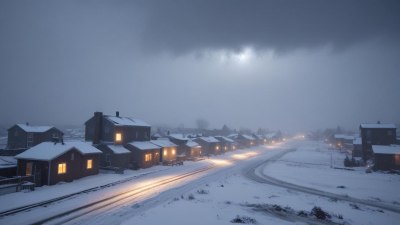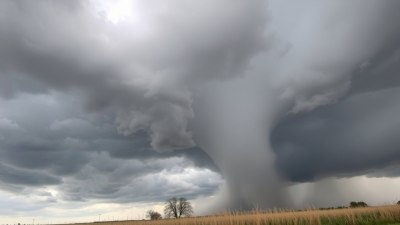How the Sun Heats the Earth Unevenly and Creates All Weather
Explore how the Sun's uneven heating of Earth drives weather patterns, winds, and climates worldwide.

Image created with Flux Schnell
The Sun is the primary source of energy for Earth's climate system, yet its radiation does not heat the planet evenly. This uneven heating is the fundamental driver behind all weather phenomena, from gentle breezes to violent storms. Understanding how the Sun's energy interacts with the Earth reveals the complex mechanisms that create the atmosphere's dynamic behavior.
At the most basic level, Earth's surface absorbs sunlight and warms, but the rate of heating varies dramatically around the globe. Factors such as Earth's spherical shape, its axial tilt, the composition and reflectivity of the surface, and atmospheric circulation all influence how solar energy is distributed. These contrasts in heating set up temperature gradients that fuel wind, precipitation, and the diversity of climates.
Solar Energy and Earth's Geometry
The Earth is a sphere that rotates on its tilted axis. Solar rays strike the planet at different angles depending on latitude and time of year. Near the equator, sunlight arrives nearly perpendicular, concentrating energy over a small area, which causes intense heating. Towards the poles, the sun's rays hit at a slant, spreading their energy over a wider area and reducing the heating intensity. Additionally, the axial tilt of approximately 23.5 degrees generates seasons by varying the sun's height in the sky throughout the year, which further modulates solar heating at different latitudes.
This geometric effect means that the equatorial regions consistently receive more solar energy than intermediate and polar zones. The temperature difference established between these regions is a key driver of atmospheric circulation. Warm air rises near the equator and cooler air sinks near the poles, creating patterns of movement that redistribute heat.
Albedo and Surface Characteristics
Albedo is the measure of how much sunlight a surface reflects. Surfaces with a high albedo, such as ice caps, snowfields, and deserts, reflect a significant portion of incoming solar radiation back into space, thereby absorbing less heat. Conversely, darker surfaces like oceans, forests, and urban areas have low albedo values and absorb more solar energy, heating up more efficiently.
For example, when snow melts and exposes darker soil underneath, the Earth's surface absorbs more heat, reinforcing warming. This feedback loop is particularly important in polar regions and affects global climate patterns. Similarly, variations in land use and vegetation cover influence how much solar radiation is absorbed or reflected, altering local temperatures and contributing to regional weather conditions.
Atmospheric Absorption and Scattering
The atmosphere is not a passive medium but actively interacts with solar radiation. Some sunlight is absorbed by gases like ozone, particularly in the ultraviolet range, while other wavelengths pass through to the surface. Clouds and aerosols scatter sunlight, diffusing energy over broader areas. The thickness and composition of the atmosphere vary with altitude and geography, influencing how much solar energy reaches the ground.
Water vapor and other greenhouse gases also absorb longwave radiation emitted from Earth's surface, trapping heat and warming the atmosphere—a process known as the greenhouse effect. This mechanism modulates the temperature difference between day and night and between seasons, adding complexity to the distribution of heat.
Heat Transfer Mechanisms
Once solar energy is absorbed, the Earth redistributes heat through conduction, convection, and radiation. Conduction transfers heat directly through materials but is limited in the atmosphere. Convection—vertical movement of air mass - is crucial as warm air rises and cool air sinks, establishing circulation cells.
Radiation allows Earth to emit infrared energy back to space, balancing incoming solar radiation over long time scales. However, the spatial imbalance caused by uneven solar heating continuously drives atmospheric and oceanic motions to balance these differences.
Atmospheric Circulation Cells
The unequal heating between the equator and poles produces large-scale circulation patterns in the atmosphere. These include the Hadley, Ferrel, and Polar cells, which consist of rising and sinking air masses that transport heat poleward. Near the equator, warm air rises and moves poleward at high altitudes before cooling and descending in subtropical regions. This circulation creates trade winds, westerlies, and polar easterlies, shaping global wind patterns.
Intersections of these cells form regions of high and low pressure that drive movement of air masses. The Coriolis effect, a result of Earth's rotation, deflects moving air, influencing wind direction and creating the spiraling patterns observed in cyclones and anticyclones.
Oceanic Influence on Heat Distribution
Oceans cover about 70% of Earth's surface and store vast amounts of solar heat. Water has a high heat capacity, meaning it warms and cools more slowly than land, moderating temperatures. Ocean currents redistribute heat from equatorial regions toward the poles. Warm currents like the Gulf Stream transport tropical heat northward, influencing climate in adjacent continents.
The interaction between ocean and atmosphere shapes weather phenomena such as monsoons, El Niño, and La Niña events. These patterns affect rainfall distribution, storm frequency, and temperature variability worldwide.
Local Factors Influencing Heating Variability
Local topography plays a critical role in modifying solar heating and weather. Mountains block airflow, create rain shadows, and cause temperature inversions. Urban areas, known as heat islands, absorb and retain more heat due to concrete and asphalt surfaces, raising local temperatures compared to surrounding rural areas.
Vegetation cover can cool regions through evapotranspiration, where plants release moisture that absorbs heat during evaporation. Differences in soil moisture, altitude, and surface roughness further contribute to regional weather variations.
Formation of Weather Systems
The uneven heating sets the stage for weather system development. Warm, moist air rises and cools, causing water vapor to condense and form clouds and precipitation. Temperature gradients between air masses generate fronts, where contrasting conditions meet. These fronts often trigger storms and shifts in wind patterns.
Low-pressure systems develop where warm air converges and rises, drawing in surrounding air, whereas high-pressure systems form from descending cool air, leading to clearer skies. The interaction between these pressure zones drives winds and weather changes daily.
Storms and Extreme Weather
Severe weather results from intensified temperature contrasts and moisture availability. Tropical cyclones, or hurricanes, form over warm ocean waters with abundant heat and moisture. These storms derive energy from the ocean and intensify due to atmospheric circulation and low vertical wind shear.
Similarly, mid-latitude cyclones develop along frontal boundaries, fueled by temperature differences between polar and tropical air masses. Thunderstorms emerge from localized heating, particularly in the afternoon, as warm unstable air rises rapidly.
Climate Zones From Solar Heating Patterns
Over longer periods, the uneven solar heating determines Earth's climate zones. Equatorial regions experience warm, wet climates year-round due to persistent solar energy and rising air. Subtropical zones tend to be dry as descending air inhibits precipitation. Temperate and polar regions undergo greater seasonal variation influenced by Earth's tilt.
The tilt and orbit cause equinoxes and solstices, shifting the zones of maximum heating and affecting day length. These cycles influence vegetation growth, animal behaviors, and human activities like agriculture.
Human Impact on Earth's Energy Balance
Human activities, including deforestation, urbanization, and greenhouse gas emissions, alter the natural distribution of heat. Increased greenhouse gases enhance the greenhouse effect, leading to global warming and changing weather patterns worldwide. Land use changes modify albedo and surface roughness, influencing local and regional climates.
Understanding how solar energy drives Earth's weather aids in predicting climate change effects, managing natural hazards, and planning sustainable development.
The Sun's energy is thus the engine behind Earth's climate system, and its uneven heating orchestrates the complex atmospheric and oceanic dances that create weather. From gentle trade winds to catastrophic storms, the diversity and dynamism of Earth's weather arise from the fundamental physical principle of uneven solar heating interacting with Earth's geometry, surface, and atmosphere.











